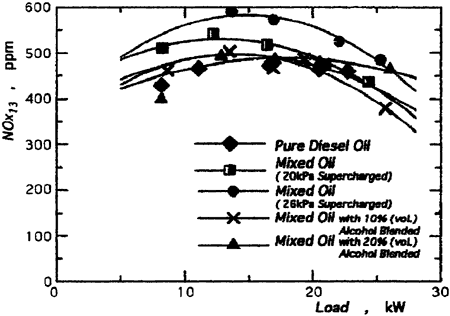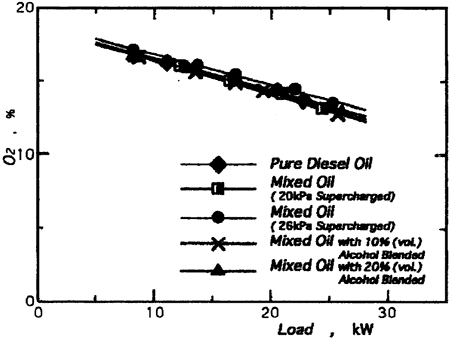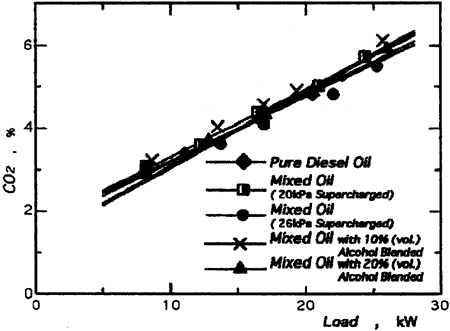Although the case of 20%(vol.) ethanol blended case turns to be unstable combustion and indicates slightly higher NOx emission, its difference is very small. From the fuel consumption aspect it is reasonable to use the diesel / rape-seed / ethanol mixed fuel oil that contains oxygen in fuel, Fig. 11.

Fig. 11 Corrected NOx Density at 13% O2 in Exhaust Gas
Residual O2 density is measured and summarized in Fig. 12. There is no apparent difference in measured results except the case of 26kPa super-charged condition with the 50% (vol.) rape-seed oil mixed fuel. It is expected that the variation in fuel consumption affect to the residual density. The oxygen in fuel, such as ethanol and rape-seed oil, seems to make the residual gas level constant in this study.

Fig. 12 O2 Density of Exhaust Gas
CO2 concentration in exhaust gas also examined for each fuel condition. Figure 13 shows the results. Although the fuel consumption becomes larger in mixed fuel cases, there seems no obvious difference in CO2 emission. The increasing rate of fuel consumption is smaller in case of the rape-speed mixed fuel oil than the case of the ethanol. Ethanol has less in carbon number compared with to diesel oil and rape seedd oil. These aspects seem to affect to the slight difference in CO2 emission.

Fig. 13 CO2 Density of Exhaust Gas
The pressure history inside combustion chamber is indicated in Fig. 14 for each mixed fuel case. The rape-seed oil was mixed 50% (vol.) to the diesel fuel oil for every case. It is assumed that the mixing of rape-seed oil make the fuel kinetic viscosity higher, so that the fuel atomization becomes worse. But short ignition delay is obtained in cases of the 50% (vol.) rape-seed oil and additional 10%(vol.) ethanol. This seems to be affected by the molecular component in the rape-seed oil, and its characteristics overcomes the bad atomization due to higher kinetic viscosity of fuel.
It is observed that the increase in blending rate of ethanol to the diesel and rape-seed mixed fuel oil produces larger ignition lag. This larger ignition delay seems to be the reason of higher NOx emission. That is, there is no apparent difference for the after burning period in Fig. 14, so the combustion period does affect to NOx emission.
Addition of ethanol to the mixed fuel gives almost same NOx emission level compared to pure diesel oil. And the 20% (vol.) seems to be the limit to obtain the stable combustion in respect to the NOx exhaust density.
BACK CONTENTS NEXT